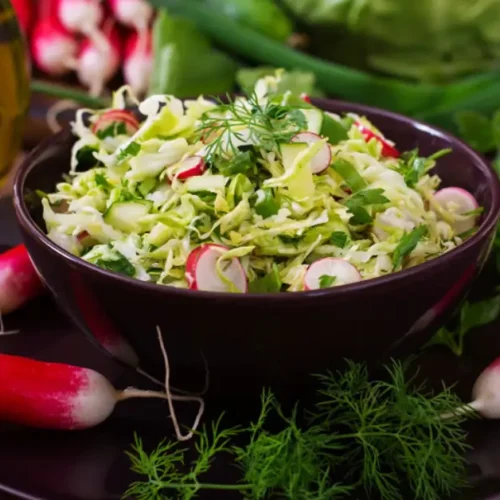Table of Contents
ToggleGreen Goddess Salad: A Classic Recipe with a Modern Twist
Salads have always been a go-to for people looking to eat light, fresh, and healthy meals. While some salads might feel basic or uninspired, the Green Goddess Salad stands apart with its bold flavors, creamy texture, and a history that dates back to the early 1920s. The name itself sounds intriguing, and for a good reason—it’s as vibrant as it is delicious.
In this article, we’ll dive deep into the origins of the Green Goddess Salad, its nutritional benefits, the versatility of the recipe, and how you can make your own with variations to suit different tastes and dietary preferences. Let’s get started on the journey of this flavorful green marvel!
The Origins of the Green Goddess Salad
The Green Goddess Salad is believed to have originated at the Palace Hotel in San Francisco in 1923. The hotel’s executive chef, Philip Roemer, created the dish as a tribute to actor George Arliss, who was starring in a play called The Green Goddess at the time. The name has since stuck, and the salad has evolved in various kitchens around the world.
The original recipe consisted of a creamy herb dressing made with mayonnaise, tarragon, parsley, and anchovies. The dressing is what sets the Green Goddess Salad apart from other salads, providing a rich, tangy flavor that complements a variety of fresh, green ingredients.
Nutritional Benefits of Green Goddess Salad
What makes this salad a popular choice is not only its delicious taste but also its rich nutritional profile. The salad is typically made with leafy greens like romaine lettuce, spinach, or kale, and is packed with essential vitamins like Vitamin A, Vitamin C, and Vitamin K. These vitamins support everything from immune function to skin health, making this salad as good for you as it is for your taste buds.
Other key ingredients such as avocados, cucumbers, and herbs provide healthy fats, fiber, and antioxidants. The creamy dressing, if made with healthy substitutes like Greek yogurt or avocado oil, can also provide a dose of probiotics and heart-healthy fats.
Key Nutrients in a Green Goddess Salad:
- Vitamins: A, C, K
- Minerals: Potassium, Iron, Magnesium
- Fiber: Improves digestion and gut health
- Antioxidants: Helps fight inflammation and reduce oxidative stress
- Healthy fats: Promote heart and brain well-being
Green Goddess Salad Variations for Every Diet
While the classic version is delicious, many modern variations cater to different dietary preferences and flavor profiles. Here are a few ideas to consider when making your Green Goddess Salad:
Vegan Green Goddess Salad
To make the salad vegan, simply swap out the mayonnaise and sour cream with plant-based alternatives. Cashew cream or vegan yogurt works well as substitutes. You can also leave out the anchovies or replace them with capers for that salty, umami flavor.
Keto-Friendly Green Goddess Salad
For those following a low-carb or keto diet, this salad can easily be adapted by using high-fat ingredients like avocado and olive oil in the dressing. You can also add in grilled chicken or shrimp to boost the protein content, making it a more substantial meal.
Gluten-Free Green Goddess Salad
Most versions of this salad are naturally gluten-free, but if you’re adding any extra toppings like croutons, make sure they are gluten-free or opt for alternatives like toasted seeds or nuts for added crunch.
Paleo Green Goddess Salad
If you follow a Paleo diet, you can use coconut yogurt or almond yogurt as a dairy substitute in the dressing. Adding proteins like grilled salmon or steak strips can also help transform the salad into a more filling meal while staying Paleo-compliant.
Spicy Green Goddess Salad
For those who love a kick of heat, add jalapeños or a pinch of red pepper flakes to the dressing. The creaminess of the dressing will balance the spice, creating a perfect harmony of flavors.
Customizing Your Green Goddess Salad with Toppings
One of the best things about the Green Goddess Salad is its versatility. You can easily mix and match toppings to suit your taste or use what you have in your kitchen. Here are some topping ideas to elevate your Green Goddess Salad:
- Add grilled chicken or tofu for an extra boost of protein.
- Quinoa or farro for a hearty grain boost
- Sliced almonds, pumpkin seeds, or hemp hearts for a nutty crunch
- Pickled pink onions for a tangy bite
- Feta cheese or goat cheese for a creamy finish
- Sliced radishes for extra freshness and a peppery flavor
The Environmental Impact of a Plant-Based Green Goddess Salad
With the rise of plant-based eating, it’s worth noting that the Green Goddess Salad can be an eco-friendly meal choice, especially when made vegan. By focusing on fresh, local greens and vegetables, you’re supporting sustainable agriculture practices and reducing your carbon footprint. Even if you choose to add a bit of animal protein, the salad is still a lighter option compared to meat-heavy dishes.
Moreover, using seasonal ingredients helps reduce food miles and ensures you’re getting the freshest produce. In summer, add fresh peas or zucchini, while in the colder months, you can mix in some roasted vegetables like Brussels sprouts or sweet potatoes for a warm variation of the salad.
The Appeal of the Green Goddess Salad in Popular Culture
While salads might not seem like the most glamorous dish, the Green Goddess Salad has held its own in both the culinary and wellness worlds. It’s been featured on many restaurant menus, from casual cafes to upscale eateries, with each chef putting their spin on the classic dish.
In the wellness community, this salad has become a staple in clean-eating regimens, thanks to its nutrient-dense ingredients. The Green Goddess dressing, in particular, is often praised for its ability to make eating greens not only tolerable but downright enjoyable.
Why the Green Goddess Salad Deserves a Spot in Your Recipe Repertoire?
The Green Goddess Salad is a timeless dish that’s as versatile as it is flavorful. Whether you’re looking for a healthy lunch option, a crowd-pleasing side dish, or a hearty meal with the addition of protein, this salad can do it all. With its origins rooted in a hotel kitchen nearly a century ago, it’s safe to say that this recipe has stood the test of time for good reason.
Whether you stick to the classic recipe or experiment with modern variations, the Green Goddess Salad is sure to add a burst of color, flavor, and nutrition to your table. So why now no longer provide it an attempt today?
What is the Green Goddess made of?
The classic Green Goddess dressing is made from a blend of fresh herbs, typically parsley, tarragon, and chives, mixed with mayonnaise, sour cream, lemon juice, and anchovies. Some variations add other green ingredients like spinach or basil. The salad often includes leafy greens, cucumbers, and other fresh vegetables to complement the dressing.
Why is it called Green Goddess salad?
The name “Green Goddess” originates from the dressing’s vibrant green color, thanks to the fresh herbs used in the recipe. It was created in the 1920s at the Palace Hotel in San Francisco and named in honor of the play The Green Goddess, starring actor George Arliss.
What does Green Goddess taste like?
Green Goddess has a rich, creamy texture with a fresh, herby flavor profile. The tanginess of lemon and sour cream balances the slight brininess of anchovies, while the herbs bring a refreshing, earthy taste.
Does Green Goddess contain avocado?
Avocado is not part of the original Green Goddess dressing recipe but is often added in modern variations to enhance creaminess and the overall green hue. Many contemporary versions of Green Goddess dressing do feature avocado as a key ingredient.

Green Goddess Salad
Equipment
- – Blender or meals processor
- – Cutting board and knife
- – Large salad bowl
Ingredients
- 1 head of romaine lettuce: or your preferred greens
- 1 cucumber: diced
- 1 avocado: sliced
- 1 cup of green beans: blanched
- 1/2 cup of fresh parsley
- 1/4 cup of fresh tarragon
- 1/4 cup of fresh chives
- 2-3 anchovies: optional, but traditional
- 1/2 cup of mayonnaise
- 1/4 cup of sour cream
- 2 tablespoons of white wine vinegar
- 1 garlic clove: minced
- Salt and pepper to taste
Instructions
- Start by preparing your dressing. In a blender, combine the mayonnaise, sour cream, fresh herbs (parsley, tarragon, chives), anchovies, vinegar, and garlic. Blend until smooth and creamy. Season with salt and pepper.
- In a bowl, mix together the lettuce, cucumber, and avocado.
- Add the blanched green beans to the salad mix for an extra crunch.
- Spot the dressing over the salad, and mix to coat.
- Garnish with extra fresh herbs if desired, and serve immediately.








18 thoughts on “The 5 best green goddess salad variations”